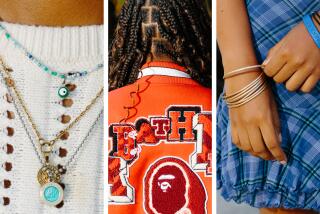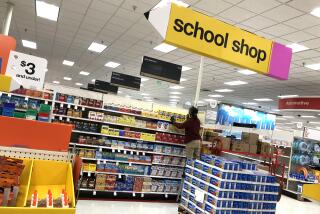A Back-to-School Boom for Office-Supply Stores
- Share via
Office superstores used to be better known for brown accordion files and pink “While You Were Out” pads, but product-hungry schoolchildren now have the stores lining their aisles with bright gel-ink pens.
The warehouse-style stationery stores offer a dazzling array: neon gel pens, metallic gel pens, and the most important product this year, according to 12-year-old Anna Engel--”super-marble” gel pens that write three colors at once.
Every fall, stores such as Staples Inc., Office Depot Inc. and OfficeMax Inc., devote more time, more attention and more marketing dollars to a fickle group of trend-driven customers, namely, students under 18.
Most of the retailers now say back-to-school is their second-largest revenue period behind January, when small businesses often update their files and equipment.
“Clearly, the sector has become more consumer-focused over the past several years, diversifying from the original focus exclusively on small business,” said Matt Fassler, a retail analyst with Goldman, Sachs & Co. in New York. “The back-to-school products are an example of the companies reaching out to new customers, both students and teachers.”
A decade after the office superstore explosion, attracting new customers is a top priority for the industry, which has struggled recently to maintain sales and revenue growth in an increasingly competitive environment.
For 2000, the back-to-school push translates into three-ring binders in the neon-and-translucent-white colors of Apple’siMac computer, date books that look like cargo pants and backpacks with wheels.
As part of courting the educational market, most of the stores also launch a flurry of school-related promotional deals.
Many collect supply lists from area schools, online or offline, so that kids can just walk in and look up what they need.
Shop at one of the chains and the store will donate 5% of the purchase to local schools in the form of additional supplies. Another offers special teachers’ breakfasts and an opportunity to shop before the business opens for the day. Most offer discounts to teachers, in hopes they will return for additional supplies later in the school year.
That tactic already worked with Audra Stout, a kindergarten teacher at Beverly Vista School in Beverly Hills, who carefully picked out 20 brightly colored pencil boxes for her students
An Office Depot store in West Los Angeles got Stout’s attention when its representatives visited the school and passed out special coupons to teachers. An advertising circular, listing the boxes at 68 cents apiece, made her choice of stores easy, she said.
Twelve-year-old Anna and her 16-year-old brother, Adrian, were also at Office Depot as a result of an promotion--this one, directed at their father, Avi Engel of Beverlywood.
He bought a cellular phone at the store over the summer and received a $50 voucher as encouragement to return. That brought his bill for two children’s worth of supplies into the $130 range.
“They’re all the same, I don’t care where I go,” Engel said. “But I was glad to come here for $50 off.”
In a competitive marketplace the three companies use those kinds of incentives to draw customers.
Delray Beach, Fla.-based Office Depot is the biggest of the three in terms of sales, with $10.3 billion in revenue for its last fiscal year, following by Framingham, Mass.-based Staples at $9 billion and Cleveland-based OfficeMax with $4.8 billion.
Staples, said Amy Ryan, a retail analyst with Prudential Securities in New York, has posted 30 consecutive quarters of meeting or exceeding analysts estimates and is likely to continue in that vein despite losses at the “dot-com” part of the business.
OfficeMax, meanwhile, has rejiggered its mix, bowing out of the volatile computer hardware business in favor of allowing Gateway to establish stores within the store.
Of the three main competitors, OfficeMax’s bottom line is most dependent on its back-to-school quarter--with analyst estimates making the October quarter sales just 3% below its biggest-selling season at the beginning of the year.
In contrast, Staples’ October quarter accounts for 5% to 6% less than the January period. Office Depot is the least dependent on back-to-school sales, with fall running anywhere from 8% to 15% below sales per store at the first part of the year, Fassler said.
Parents this year told researchers they will spend more money than ever before on school supplies--about $549 for every household with school children, or roughly $11.3 billion total, according to the National Retail Federation.
Most back-to-school money is spent on clothes. This year, American Express Retail Index said teens and their parents will spend an average of 20% more than last year, or $548 per teenager.
But apparel sellers may not be the beneficiary of that extra spending, since August was a bust for many of them.
Some of the clothing sellers’ problems are likely due to a long-term trend of kids stretching their back-to-school money, analysts said.
The office superstores, however, are quick to suggest that their big-ticket items, such as computer hardware and software, could be siphoning off money that in years past would have been allocated to wardrobe enhancement.
“It’s amazing how things have changed since we were kids,” said Robert Moore, Staples’ executive vice president of marketing. “Big sellers for back-to-school now are pagers, cell phones and Palm Pilots.”
Back when pens came in three colors--blue, black and red--there were about as many places to buy them: drugstores, mass merchandisers and local stationers.
But none of the those can offer the selection of the office stores--a key factor for kids wanting the coolest product. Although parents may prefer the convenience of one-stop shopping for all family needs, a la Wal-Mart, their kids tend to want lots of choices.
Anna, who was getting ready to start seventh grade at Maimonides Academy in Los Angeles, put it this way:
“We need a lot of colors because we like to decorate our papers,” she said, choosing the multi-pack of rainbow highlighter markers rather than the more spartan trio of yellow ones. “Some places just don’t have as many.”
(BEGIN TEXT OF INFOBOX / INFOGRAPHIC)
Costlier Fall
Parents and teenagers are expected to spend 20% more during this year’s back-to-school shopping season, which has become second only to January for sales at
office-supply stores.
Total back-to-school spending per teenager:
1998: $408
1999: $455
2000: $548
Source: 2000 American Express Retail Index
More to Read
Inside the business of entertainment
The Wide Shot brings you news, analysis and insights on everything from streaming wars to production — and what it all means for the future.
You may occasionally receive promotional content from the Los Angeles Times.










